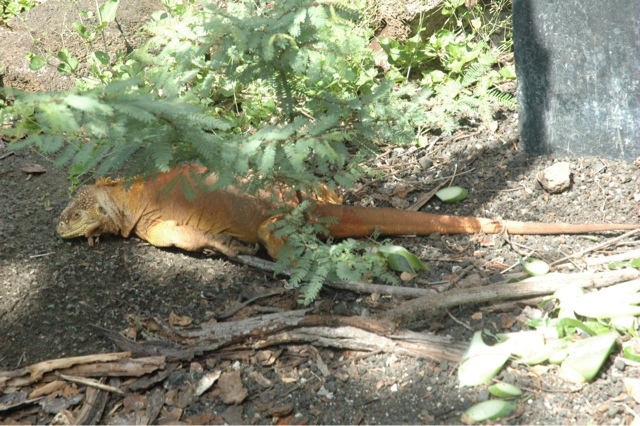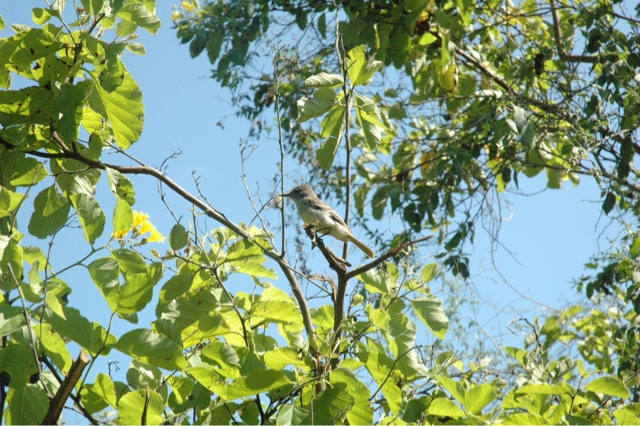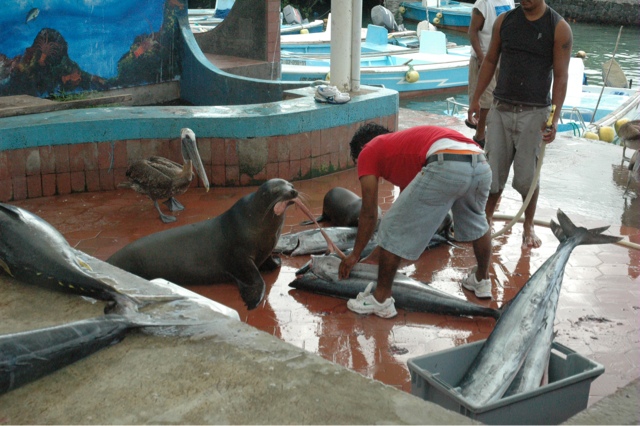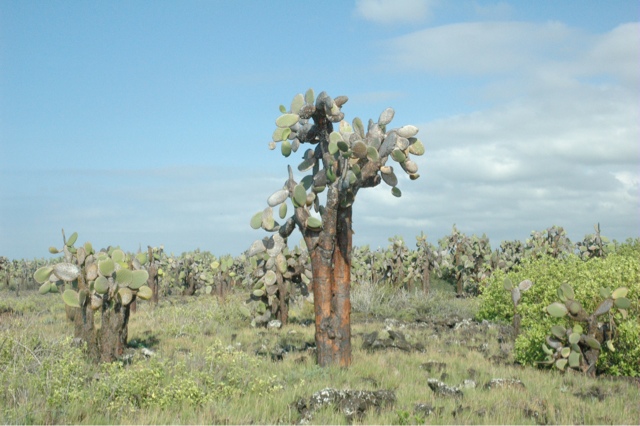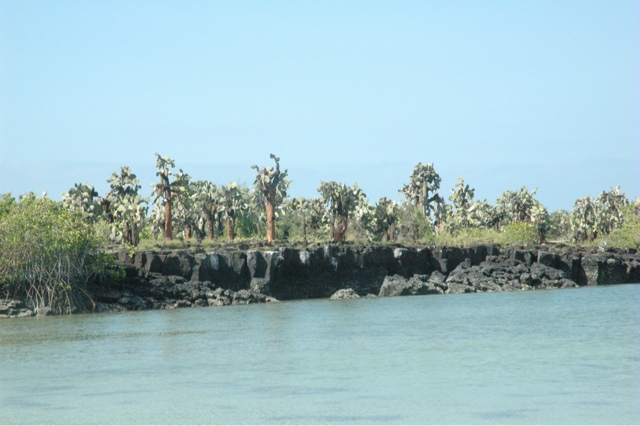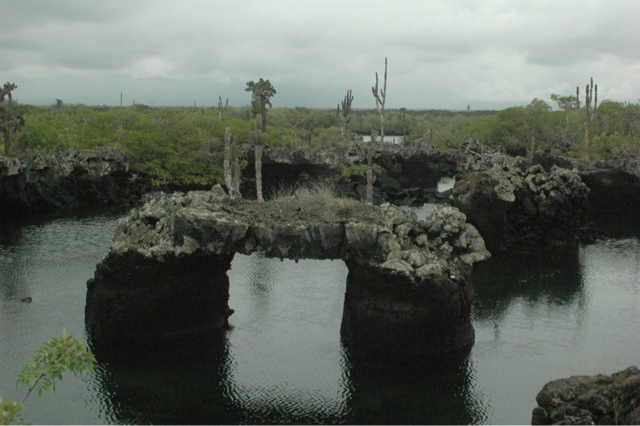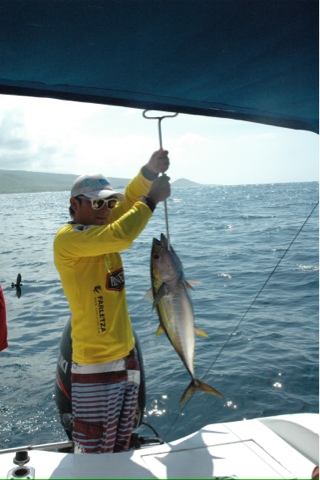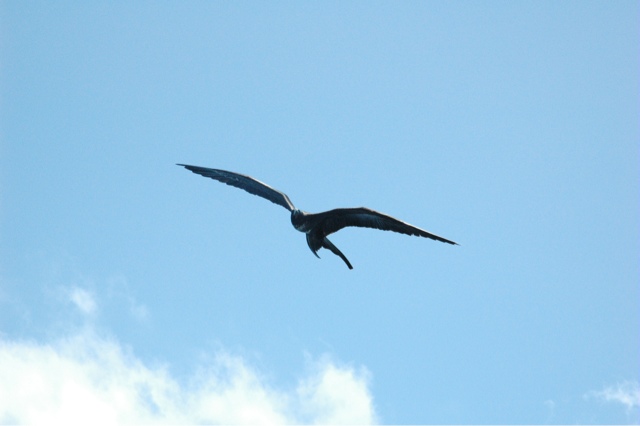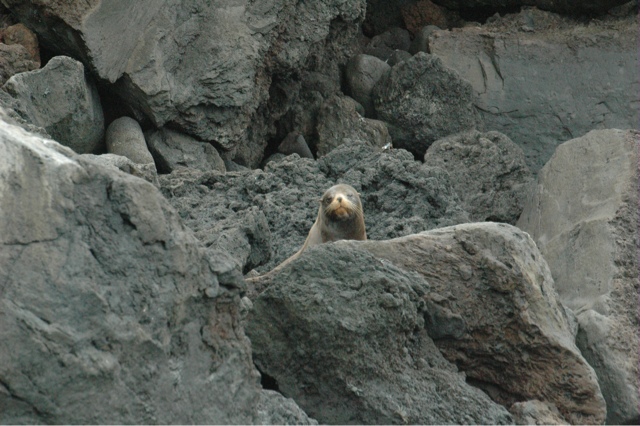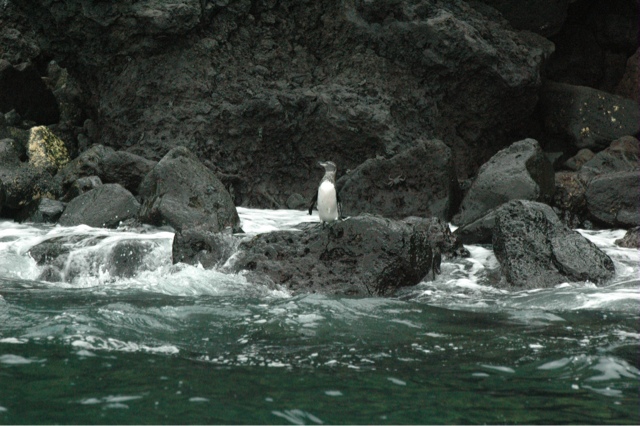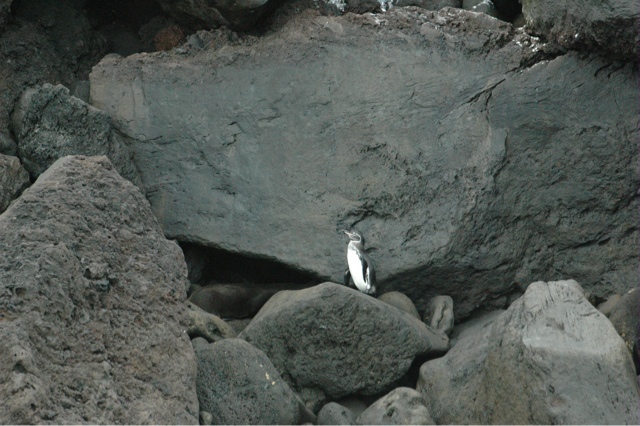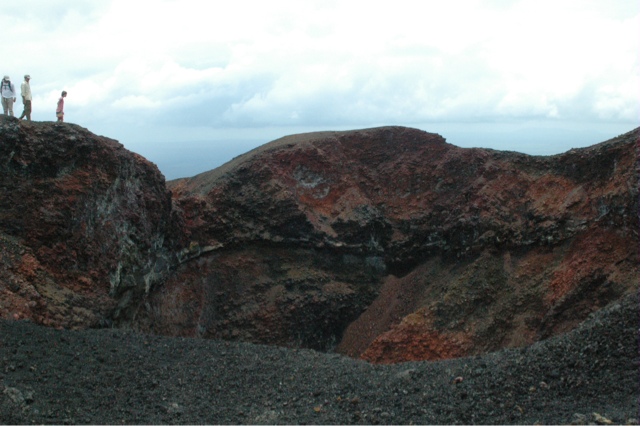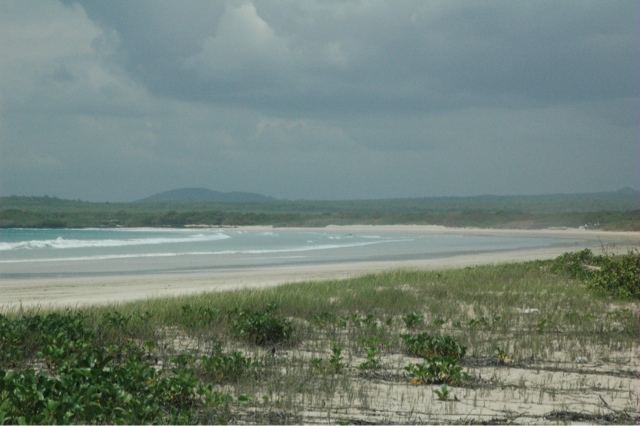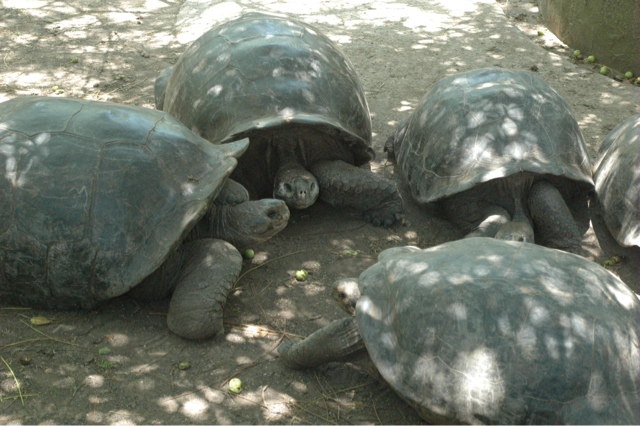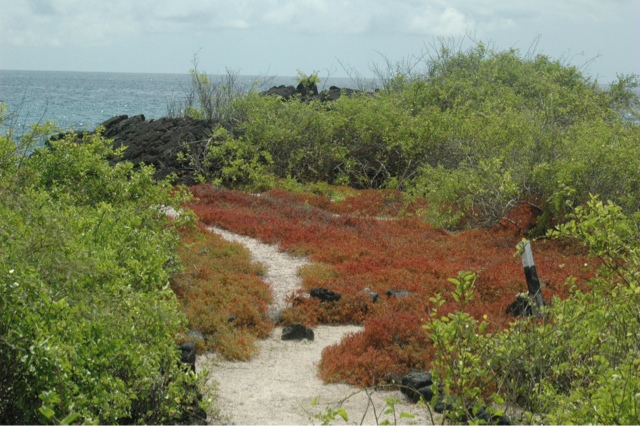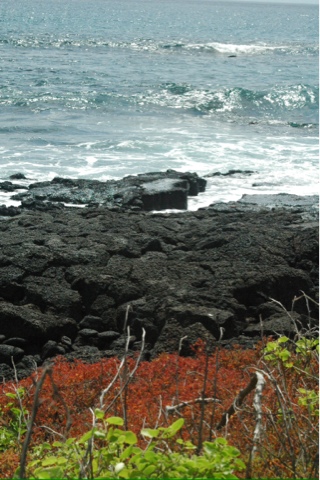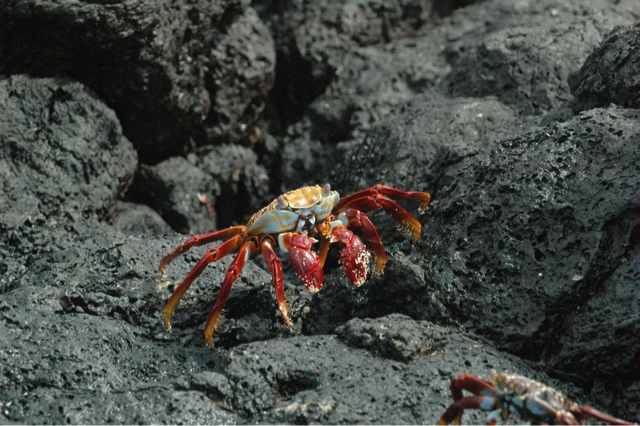We have seen plenty of turtles and tortoises, sea lions, iguanas, Darwin's finches, frigate birds, pelicans, herons and various other birds and lizards to last us for a good long while. Almost to the point that we are taking all this nature and wildlife a little for granted. It takes a lot to catch our attention these days. Even the black tipped reef sharks swimming under and around our boat here at the anchorage don't have me running for my camera any longer. Shameful to admit how easily we get spoiled.
But, knowing we will soon be leaving these enchanted islands has me feeling a little melancholic. I can't help but take a last trip to the Darwin Center for another look at the place where Lonesome George spent his last days. And to see the colorful land iguanas basking in the sun
The harsh environment that these creatures endured and prospered in is a difficult one to tame. But even people have managed to carve a life out of the volcanic rock landscape and luckily the highlands have given them rich soils and enough rain to raise cows and plant small farms. Farms that produce good sized watermelons, cabbages, pineapples, tomatoes, and many other fruits and vegetables.
The very touristy town of Puerto Ayora with its dive shops, souvenir shops and restaurants has been getting a facelift. The main street is looking better every day with the addition of a bicycle lane, covered benches and trees. By far our favourite attraction is the fisherman's wharf. The local fisherman arrive with the catch of the day and proceed to gut and filet the fish. It is also the main attraction for all kinds of creatures hoping for a scrap including the sea lion, iguana, pelican and heron, not to mention those of us there to watch and perhaps buy a filet of wahoo for the nights dinner. It is interesting to observe the pecking order for the fish scraps. Sea lions rule, but the pelicans are fearless. The frigate birds show their true colors as the 'pirates of the sea' and will dive in and steal from almost anyone while the heron staidly stands back seeming too proud to beg but hoping a piece will slip his way. But the fisherman have the final say and sometimes when the greedy ones get too close they resort to using the wooden stick. These animals know the stick and just the act of reaching for the stick has them backing away a step or two.
So, a few last photos. Caution to readers, there is an x-rated photo below. Jens and I were caught up with a little turtle porn the other day. I guess the rain got them feeling a little frisky and the only one that seemed a bit embarrassed when I took out my camera was the poor gal at the bottom. Try as she might, she had nowhere to hide.
We also discovered that the cactus trees in the below photo only grow here on Galapagos. They are quite dramatic looking don't you think. Yet another species endemic to Galapagos together with the Galapashark, Galapaguanas, Galapaturtle, Galapafinch and Galapaseal. Oh yes, don't forget the Galapaguin and the very famous Galapatourist idientifiable by the ranger gear complete with floppy hat, long sleeved khaki shirt and matching pants, but not to be confused with the Common Gringo that usually stick to the mainland.
Saturday, March 30, 2013
Thursday, March 28, 2013
Puddle Jumping
Another full moon which must mean we have been in Galapagos for almost a month. It's a difficult task to know what day of the week it is or what day of the month, and sometimes it is even a challenge to remember which month we are in. Life at the equator is quite simple. The sunrises as 6 AM every day and sets at 6 PM every day and the weather is pretty much the same every day of the year. We hear tell of signs of Spring in the Northern Hemisphere from our friends back home. Spring teasing with a few days when the sun is warm on your face and the snow is melting away enough to see the first green tips of tulips and daffodils. A nice reward for having made it through another cold winter. But not for us. We have to watch out for the scorching sun and have come to fully appreciate the siesta taken by all the shop keepers between 12:30 and 3:00 PM. It is really just too hot to do anything but find a shady spot and limit movements as much as possible. Even the trees wilt under the noonday sun.
We are slowly getting ourselves ready for crossing the Pacific Ocean or the 'puddle jump' as the cruisers like to call it. Engine oils checked, bright work done, blocks lubricated and safety pins taped. After a lot of Internet research and phone calls to the supplier, Jens has come to terms with our new batteries. He has accepted the fact that they are not as good as the Life Line batteries we replaced last month but will do even though we have to make a few adjustments as to how we use our energy.
We will top up our fuel, water and propane tanks on Tuesday and make a last trip to the vegetable market on Wednesday. If the weather is fine, we plan to leave late Wednesday morning (April 3rd ... I checked the calendar). We have been shopping a bit every day and I will have a full inventory of groceries and a full freezer by the weekend. We plan to catch some fish along the way, so we have restocked our inventory of fishing lures.
The puddle jump will be the longest sea voyage for me and SY SEGWUN. Captain Jens has crossed the Pacific by sea several times during his years working for Maersk as a Marine Engineer. But this will be his first crossing as Captain and in a sailboat. So, lots of planning and preparation have been done. We have paper maps, a plotter, Navionics on the iPad, GPS applications on both the iPad and the iPhone and our satellite phone can send our GPS location in an email. We should have no difficulty knowing where we are at any given moment.
As regard to safety, we have our EPIRB (Emergency Position Indicating Radio Beacon) which will automatically send an emergency message via satellite to the International Search and Rescue agencies when activated or submersed in water, we have our life raft fully equipped with a multitude of food, medical and emergency items and we have our medical emergency kit which has everything you need to supply a small hospital.
I think we are ready. The only danger that I can think of is how to cope with the boredom. But Jens assures me that I will be too tired from doing night watches to be bored. Ha ha.
We are slowly getting ourselves ready for crossing the Pacific Ocean or the 'puddle jump' as the cruisers like to call it. Engine oils checked, bright work done, blocks lubricated and safety pins taped. After a lot of Internet research and phone calls to the supplier, Jens has come to terms with our new batteries. He has accepted the fact that they are not as good as the Life Line batteries we replaced last month but will do even though we have to make a few adjustments as to how we use our energy.
We will top up our fuel, water and propane tanks on Tuesday and make a last trip to the vegetable market on Wednesday. If the weather is fine, we plan to leave late Wednesday morning (April 3rd ... I checked the calendar). We have been shopping a bit every day and I will have a full inventory of groceries and a full freezer by the weekend. We plan to catch some fish along the way, so we have restocked our inventory of fishing lures.
The puddle jump will be the longest sea voyage for me and SY SEGWUN. Captain Jens has crossed the Pacific by sea several times during his years working for Maersk as a Marine Engineer. But this will be his first crossing as Captain and in a sailboat. So, lots of planning and preparation have been done. We have paper maps, a plotter, Navionics on the iPad, GPS applications on both the iPad and the iPhone and our satellite phone can send our GPS location in an email. We should have no difficulty knowing where we are at any given moment.
As regard to safety, we have our EPIRB (Emergency Position Indicating Radio Beacon) which will automatically send an emergency message via satellite to the International Search and Rescue agencies when activated or submersed in water, we have our life raft fully equipped with a multitude of food, medical and emergency items and we have our medical emergency kit which has everything you need to supply a small hospital.
I think we are ready. The only danger that I can think of is how to cope with the boredom. But Jens assures me that I will be too tired from doing night watches to be bored. Ha ha.
Thursday, March 21, 2013
Sant Cruz Island, Galapagos
We have sailed (actually, we motored most of the way because the wind was right on our nose) from San Isabela to Santa Cruz on Monday. Santa Cruz is the island between San Isabela and San Cristobal, so we have actually backtracked a little. The reason is that Santa Cruz has more in the way of shops for our final provisioning before our crossing so we wanted this to be our last port. Also, we will say farewell to Anna and Christian here as they will hop on a ferry and sail over to San Cristobal where they will take a flight to mainland Ecuador and then on to Europe on April 1st. Sadly, our cruising days with them are quickly dwindling and they will soon be back to the real life in Denmark.
We haven't done much in the way of visiting the sights since we arrived. We have been too busy fretting over our new batteries (they are not quite as good as we expected), sourcing last minute spare parts, getting information about fuel, water and propane, checking out the grocery shops in preparation for our last big provisioning, and booking a berth in New Zealand for December.
We have heard stories of Isle Marqueses and the high price of food. So, we decided that we will buy as much as we can carry before we leave port. Mind you, the prices in Galapagos are about 30% higher or more than in mainland Ecuador. For example, a 2 liter container of yogurt is costing us $8.00 vs $4.00 in Salinas. Well, that prompted us to look into making our own yogurt. The process seems incredibly simple and I wonder why we never did this before. We will try it out and report back. If it is as fool proof as they claim, I think this will mean that we will have fresh yogurt for the rest of our journey! Hooray!
Our minds are on the crossing but we still have at least 10 days on Galapagos and there are a few more places we want to see. This island is home to the Darwin Center and there are some interesting day trips. Perhaps tomorrow we will find ourselves on shore, ready to explore!
We haven't done much in the way of visiting the sights since we arrived. We have been too busy fretting over our new batteries (they are not quite as good as we expected), sourcing last minute spare parts, getting information about fuel, water and propane, checking out the grocery shops in preparation for our last big provisioning, and booking a berth in New Zealand for December.
We have heard stories of Isle Marqueses and the high price of food. So, we decided that we will buy as much as we can carry before we leave port. Mind you, the prices in Galapagos are about 30% higher or more than in mainland Ecuador. For example, a 2 liter container of yogurt is costing us $8.00 vs $4.00 in Salinas. Well, that prompted us to look into making our own yogurt. The process seems incredibly simple and I wonder why we never did this before. We will try it out and report back. If it is as fool proof as they claim, I think this will mean that we will have fresh yogurt for the rest of our journey! Hooray!
Our minds are on the crossing but we still have at least 10 days on Galapagos and there are a few more places we want to see. This island is home to the Darwin Center and there are some interesting day trips. Perhaps tomorrow we will find ourselves on shore, ready to explore!
Tuesday, March 19, 2013
Three Adventures on San Isabel
Diving Quatros Hermanos and Isla Tortugas
We jumped on a speed boat at 7:30 am. 280 horsepowers and an hour later and we were pulling on the wet suits getting ready to 'swim with the fishes' as they say. Quatros Hermanos means four brothers and is a group of four small islands near the coast of San Isabela. We passed Isla Tortuga on our way from Floreana and it is a crescent shaped rock which looks like it may have been the rim of a volcanic crater. Both Quatro Hermanos and Tortuga are popular dive spots where they often see hammerhead sharks, whale sharks and manta rays.
On the wall of one of the islands is a grotto which our dive boat slowly backed into. We could hear sea lions and see birds nesting on the walls. We came back out and did our back flips into the sea. The water was a lovely 21.5 degrees Celsius and visibility was about 15 meters. The sea lions jumped in the water and entertained us with their underwater acrobatics. But, pay attention because just there is a small bull tailed ray and look at that school of fish just ahead, there are so many of them! Oh, wow. Look at the rock formations. It is easy to see that this was formed by a volcanic eruption hundreds of thousands of years ago. Oh, and there is a white tipped reef shark resting on the bottom. How cool is that. Oops, too close now and off he goes. I guess we interrupted his nap. Check my depth...we are at about 13 meters. That's a good depth, still a lot of light. And here comes a turtle, oops, there goes the turtle. Yes, I see a beautiful star fish. Oh and another one, oh wait there's two more, no six, no it looks like maybe a dozen or more here. Wow, nice designs on these ones. Oh, there's a baby one. I love star fish. I wonder if there are as many stars in the sea as there are in the sky. We saw a lot of star fish in San Blas. Paco, our dive master is trying to get my attention .... Darn, there goes a hammerhead. Missed that one. But that's ok, cause I am suddenly surrounded by a school of barracuda. Nice. Time to check our air levels. All is good. Ok, now we have a little current here and we are all just drifting along. Another turtle. I must learn to differentiate between the green turtle and the sea turtle. Next time we are on the Internet, I need to look that up. My, it is so peaceful under here. Look at those damselfish. They are really pretty. And there's a parrotfish. What is that thing that just floated by. It's so small. Oh my. It looks like a baby jelly fish. Oh, now I see more of them. Bigger ones now. With long threads hanging down. I am sure they sting. Glad to have a wetsuit with a built in hood. The only thing exposed is my face not covered by my mask. Gosh, there is actually a huge mess of these jellyfish. They are everywhere around us. Look at how they move so gracefully. We're getting a little deeper now. Got to equalize my ears again. The water is looking a little wavy under here. Uhuh. It's a thermocline and the temperature has dropped suddenly. Brrr. Man that is a cold one. I think I'll go up a meter and try to find the warmer water. Ok, now Paco is signaling us. It is time to do our decompression stop. Seems we have reached our time limit. We make our way up to five meters and hang there for three minutes before getting to the surface and back to the boat. A great dive. Lots and lots of life in this ocean. Even without seeing 'the big three', it has been an excellent dive.
Los Tunneles
The next day we were off again with Paco and Julio, our boat captain. And they brought another crew member. Whiskey is his name. He'll help out the Captain when it comes to navigating through the maze of lava. This time we are headed west. Los Tunneles is a lava flow that has reached the ocean with the lava hardening on the surface more quickly due to the cold water of the sea while the hot molten lava continues to flow underneath. Over time, these tunnels collapse and erode creating interesting formations and many pools of water where the aquatic life is plentiful. The tricky part of this journey is getting through the surf.
Julio waits for the right moment, riding the waves in and hitting the entry point perfectly between two rocky areas. It is a narrow gap and he has to watch that the wave behind us doesn't swamp us or knock us into a rock. He is extremely skilled, managing those two horses well and once over the surf he guides us through the rock formations. We have an opportunity to walk along the tops of some of the tunnels, where the blue footed boobies have their nests. We see large turtles swimming, cactus growing on the tops of these tunnels and many small finches. And, as with every bit of rocky coastline here in the Galapagos, there are many crabs running about.
We do a bit of snorkeling in and around and through the tunnels swimming with the turtles and small rays. Back in the boat again and Julio has to get us out of this bay through the waves that are five to six meters high now. He powers through and after a few tense seconds we are safely on the other side.
We head to another great snorkeling spot where we see white tip reef sharks hiding in small caves. I just love exploring these waters and although there isn't so much coral, the lava rocks make it quite interesting.
Penguins, Flightless Cormorant, Whales and Yellow Finned Tuna
We spent a third day with Paco, Julio and Whiskey in their speedboat Rafael. This time we headed up the west coast of San Isabel looking for penguins. Zipping along the coast we see huge great lava fields, cone vents and craters. On this side, it is clearly an active island.
Whiskey spots a school of Albacore (tuna) and we slow down to get the fishing rods out. Within five minutes we had caught a beautiful yellow finned tuna. In anticipation of such a catch, they brought all the makings of Ceviche (onion, lime, salt, tomato and green pepper) and that was to be the treat of the day.
We motored for four hours covering about 80 nautical miles, far enough north that we could see Isla Fernandina in the distance. We saw the flightless cormorants in the water and nesting on the shore. Julio took us into a small bay where we swam with sea lions and turtles and got quite close to the flightless cormorants. Their wings are very short and stubby and I wonder if they look at the frigate birds swooping and diving around them with a bit of envy. Mind you, the frigate birds can not go in the water as their feathers don't have the coating of oil that is necessary to protect them and keep them afloat. They can only dive down and scoop up fish near the surface of the water. Or, they steal the catch of other birds, giving them the nickname of pirates of the sea.
While we were snorkeling, Chef Whiskey started preparing the tune for the ceviche. The frigate birds were circling around as he would toss the scraps in the air. They would get snapped up before even touching the water. What a show that was.
After lunch and ceviche we headed off to another small cove. Remember, we still hadn't seen the penguins! And, of course, Paco would not let us down. The penguins were patiently waiting for us on the rocks. They were so cute standing tall ready to have their photo taken before showing us how they can dive into the surf and then scramble out again. We also jumped in for some snorkeling. The water on the west side of the island is very cold, probably 17 degrees c at best. But, I can say it was worth it. The turtles and the rays love this cove. We saw so many I couldn't keep track. They were just lovely to be with.
On the way back we spotted a couple of whales, saw lots of manta rays and swung by Union Island for a few beauty shots. Another fantastic day!
We jumped on a speed boat at 7:30 am. 280 horsepowers and an hour later and we were pulling on the wet suits getting ready to 'swim with the fishes' as they say. Quatros Hermanos means four brothers and is a group of four small islands near the coast of San Isabela. We passed Isla Tortuga on our way from Floreana and it is a crescent shaped rock which looks like it may have been the rim of a volcanic crater. Both Quatro Hermanos and Tortuga are popular dive spots where they often see hammerhead sharks, whale sharks and manta rays.
On the wall of one of the islands is a grotto which our dive boat slowly backed into. We could hear sea lions and see birds nesting on the walls. We came back out and did our back flips into the sea. The water was a lovely 21.5 degrees Celsius and visibility was about 15 meters. The sea lions jumped in the water and entertained us with their underwater acrobatics. But, pay attention because just there is a small bull tailed ray and look at that school of fish just ahead, there are so many of them! Oh, wow. Look at the rock formations. It is easy to see that this was formed by a volcanic eruption hundreds of thousands of years ago. Oh, and there is a white tipped reef shark resting on the bottom. How cool is that. Oops, too close now and off he goes. I guess we interrupted his nap. Check my depth...we are at about 13 meters. That's a good depth, still a lot of light. And here comes a turtle, oops, there goes the turtle. Yes, I see a beautiful star fish. Oh and another one, oh wait there's two more, no six, no it looks like maybe a dozen or more here. Wow, nice designs on these ones. Oh, there's a baby one. I love star fish. I wonder if there are as many stars in the sea as there are in the sky. We saw a lot of star fish in San Blas. Paco, our dive master is trying to get my attention .... Darn, there goes a hammerhead. Missed that one. But that's ok, cause I am suddenly surrounded by a school of barracuda. Nice. Time to check our air levels. All is good. Ok, now we have a little current here and we are all just drifting along. Another turtle. I must learn to differentiate between the green turtle and the sea turtle. Next time we are on the Internet, I need to look that up. My, it is so peaceful under here. Look at those damselfish. They are really pretty. And there's a parrotfish. What is that thing that just floated by. It's so small. Oh my. It looks like a baby jelly fish. Oh, now I see more of them. Bigger ones now. With long threads hanging down. I am sure they sting. Glad to have a wetsuit with a built in hood. The only thing exposed is my face not covered by my mask. Gosh, there is actually a huge mess of these jellyfish. They are everywhere around us. Look at how they move so gracefully. We're getting a little deeper now. Got to equalize my ears again. The water is looking a little wavy under here. Uhuh. It's a thermocline and the temperature has dropped suddenly. Brrr. Man that is a cold one. I think I'll go up a meter and try to find the warmer water. Ok, now Paco is signaling us. It is time to do our decompression stop. Seems we have reached our time limit. We make our way up to five meters and hang there for three minutes before getting to the surface and back to the boat. A great dive. Lots and lots of life in this ocean. Even without seeing 'the big three', it has been an excellent dive.
Los Tunneles
The next day we were off again with Paco and Julio, our boat captain. And they brought another crew member. Whiskey is his name. He'll help out the Captain when it comes to navigating through the maze of lava. This time we are headed west. Los Tunneles is a lava flow that has reached the ocean with the lava hardening on the surface more quickly due to the cold water of the sea while the hot molten lava continues to flow underneath. Over time, these tunnels collapse and erode creating interesting formations and many pools of water where the aquatic life is plentiful. The tricky part of this journey is getting through the surf.
Julio waits for the right moment, riding the waves in and hitting the entry point perfectly between two rocky areas. It is a narrow gap and he has to watch that the wave behind us doesn't swamp us or knock us into a rock. He is extremely skilled, managing those two horses well and once over the surf he guides us through the rock formations. We have an opportunity to walk along the tops of some of the tunnels, where the blue footed boobies have their nests. We see large turtles swimming, cactus growing on the tops of these tunnels and many small finches. And, as with every bit of rocky coastline here in the Galapagos, there are many crabs running about.
We do a bit of snorkeling in and around and through the tunnels swimming with the turtles and small rays. Back in the boat again and Julio has to get us out of this bay through the waves that are five to six meters high now. He powers through and after a few tense seconds we are safely on the other side.
We head to another great snorkeling spot where we see white tip reef sharks hiding in small caves. I just love exploring these waters and although there isn't so much coral, the lava rocks make it quite interesting.
Penguins, Flightless Cormorant, Whales and Yellow Finned Tuna
We spent a third day with Paco, Julio and Whiskey in their speedboat Rafael. This time we headed up the west coast of San Isabel looking for penguins. Zipping along the coast we see huge great lava fields, cone vents and craters. On this side, it is clearly an active island.
Whiskey spots a school of Albacore (tuna) and we slow down to get the fishing rods out. Within five minutes we had caught a beautiful yellow finned tuna. In anticipation of such a catch, they brought all the makings of Ceviche (onion, lime, salt, tomato and green pepper) and that was to be the treat of the day.
We motored for four hours covering about 80 nautical miles, far enough north that we could see Isla Fernandina in the distance. We saw the flightless cormorants in the water and nesting on the shore. Julio took us into a small bay where we swam with sea lions and turtles and got quite close to the flightless cormorants. Their wings are very short and stubby and I wonder if they look at the frigate birds swooping and diving around them with a bit of envy. Mind you, the frigate birds can not go in the water as their feathers don't have the coating of oil that is necessary to protect them and keep them afloat. They can only dive down and scoop up fish near the surface of the water. Or, they steal the catch of other birds, giving them the nickname of pirates of the sea.
While we were snorkeling, Chef Whiskey started preparing the tune for the ceviche. The frigate birds were circling around as he would toss the scraps in the air. They would get snapped up before even touching the water. What a show that was.
After lunch and ceviche we headed off to another small cove. Remember, we still hadn't seen the penguins! And, of course, Paco would not let us down. The penguins were patiently waiting for us on the rocks. They were so cute standing tall ready to have their photo taken before showing us how they can dive into the surf and then scramble out again. We also jumped in for some snorkeling. The water on the west side of the island is very cold, probably 17 degrees c at best. But, I can say it was worth it. The turtles and the rays love this cove. We saw so many I couldn't keep track. They were just lovely to be with.
On the way back we spotted a couple of whales, saw lots of manta rays and swung by Union Island for a few beauty shots. Another fantastic day!
Friday, March 15, 2013
Volcan Sierra Negra and Volcan Chicos
What a fabulous day we had yesterday. We made a trip up to see the volcanoes on the south end of San Isabela, Volcans Sierra Negra and Chicos. It was a hike of about 16 kilometers round trip. We were together with the crews of Enchantment (another Island Packet), True Blue, and My Muse.
The hike takes you through the highlands where there is an abundance of plant life. The wild guava trees that grow here are heavy with brown, grey and red mosses, the small finches and flycatchers and mockingbirds are flitting about and the wild flowers and ferns decorate the sides of the trails. It was almost like walking through someone's garden.
We soon reached the rim of Sierra Negra, an absolutely awesome sight. This volcano last erupted in 2005 raising the bed of the crater by 10 meters. The crater is 10 kilometers by 9 kilometers giving a circumference of about 30 kilometers and because of the size of the crater and the type of gases and minerals in the volcano it was not an explosive eruption nor did the lava flow over the sides of the volcano. In fact, many town people came up in the evening to have a look at the fiery molten lava and snap some pictures. The lava rocks are still hot in the crater and when it rains, steam can be seen rising. So needless to say, we could not walk down to the surface.
We continued on to the Volcan Chicos. This is a huge lava field where we saw lava tunnels and many small vents which still emit a lot of heat. The last activity was in 1979 and here the colors of the rocks show evidence of sulphur (giving yellow color to the lava) and iron (giving the red color to the lava).
Walking through this lava field was like walking on another planet. The rocks were incredibly light and on close inspection some had all the colors of the rainbow on them. Our guide explained the geology behind these volcanoes and the islands in general. Scientists are still discovering things about our planet, sometimes changing assumptions and theories made in the past. In particular there is new evidence that there had been a group of islands between the Galapagos and the mainland that have sunken into the ocean. This may better explain how the turtles and other non-sea faring animals came to be on Galapagos, It was believed they arrived on rafts of vegetation from the mainland, which is a incredible distance. Another set of islands would have greatly reduced the distance they would have traveled.
The hike takes you through the highlands where there is an abundance of plant life. The wild guava trees that grow here are heavy with brown, grey and red mosses, the small finches and flycatchers and mockingbirds are flitting about and the wild flowers and ferns decorate the sides of the trails. It was almost like walking through someone's garden.
We soon reached the rim of Sierra Negra, an absolutely awesome sight. This volcano last erupted in 2005 raising the bed of the crater by 10 meters. The crater is 10 kilometers by 9 kilometers giving a circumference of about 30 kilometers and because of the size of the crater and the type of gases and minerals in the volcano it was not an explosive eruption nor did the lava flow over the sides of the volcano. In fact, many town people came up in the evening to have a look at the fiery molten lava and snap some pictures. The lava rocks are still hot in the crater and when it rains, steam can be seen rising. So needless to say, we could not walk down to the surface.
We continued on to the Volcan Chicos. This is a huge lava field where we saw lava tunnels and many small vents which still emit a lot of heat. The last activity was in 1979 and here the colors of the rocks show evidence of sulphur (giving yellow color to the lava) and iron (giving the red color to the lava).
Walking through this lava field was like walking on another planet. The rocks were incredibly light and on close inspection some had all the colors of the rainbow on them. Our guide explained the geology behind these volcanoes and the islands in general. Scientists are still discovering things about our planet, sometimes changing assumptions and theories made in the past. In particular there is new evidence that there had been a group of islands between the Galapagos and the mainland that have sunken into the ocean. This may better explain how the turtles and other non-sea faring animals came to be on Galapagos, It was believed they arrived on rafts of vegetation from the mainland, which is a incredible distance. Another set of islands would have greatly reduced the distance they would have traveled.
Wednesday, March 13, 2013
The Wall of Tears
We woke up this morning and found that nine new cruise ships had arrived to this anchorage during the night. After being in Galapagos for two weeks now, I think we have seen all of the different cruise boats that tour the waters here. They come in various shapes and sizes, from catamarans for groups of 12 to large ships taking more than a hundred passengers to dive boats dedicated to exploring all the dive sites around the islands. It is a good way to visit the Galapagos as every boat has a naturalist on board and they cover a lot of the islands picking up anchor in the evening and traveling to the next island during the night.
Our cruising permit only allows us to anchor at four of the islands and we can only visit many of the sites and other islands by joining a tour with a naturalist. But each island has some trips that you can do on your own, and so far it has been a good balance. The tours can be pricey but on the other hand the naturalists provide a lot of information on the animal, plant and sea life around you.
Yesterday we got together with True Blue and Kohiba and shared a taxi ride up to the old prison site. The crew from both True Blue and Kohiba are on their way back to Australia after about ten years of sailing. Suzie, on True Blue has been a wealth of information on the areas in the South Pacific and they have all been really good company.
The prison was built on an old US military base which housed a radar center to provide early warnings in protecting the Panama Canal during the second world war. All that remains of the prison is a wall made of volcanic rock stretching 100 meters long and 7 meters high. The prisoners were forced to build this wall that served little purpose other than to keep the prisoners busy. The guards were said to be extremely cruel and would literally work the prisoners to death. The wall became known as the 'wall of tears', where the strong cry and the weak die. The prison closed in 1959 after the inhumane practices became known by the international community.
On the walk back we stopped at a nice lookout point, explored a few lagoons and beautiful, white sand beaches. Seven kilometers later, we reached town once again just in time for a cold beer and lunch at Aloha Betsy.
Our cruising permit only allows us to anchor at four of the islands and we can only visit many of the sites and other islands by joining a tour with a naturalist. But each island has some trips that you can do on your own, and so far it has been a good balance. The tours can be pricey but on the other hand the naturalists provide a lot of information on the animal, plant and sea life around you.
Yesterday we got together with True Blue and Kohiba and shared a taxi ride up to the old prison site. The crew from both True Blue and Kohiba are on their way back to Australia after about ten years of sailing. Suzie, on True Blue has been a wealth of information on the areas in the South Pacific and they have all been really good company.
The prison was built on an old US military base which housed a radar center to provide early warnings in protecting the Panama Canal during the second world war. All that remains of the prison is a wall made of volcanic rock stretching 100 meters long and 7 meters high. The prisoners were forced to build this wall that served little purpose other than to keep the prisoners busy. The guards were said to be extremely cruel and would literally work the prisoners to death. The wall became known as the 'wall of tears', where the strong cry and the weak die. The prison closed in 1959 after the inhumane practices became known by the international community.
On the walk back we stopped at a nice lookout point, explored a few lagoons and beautiful, white sand beaches. Seven kilometers later, we reached town once again just in time for a cold beer and lunch at Aloha Betsy.
Turtles and Tortoises
We have seen the land turtles on all three islands so far. We have been to three breeding centers, the one on Isabela being the largest so far and the only one breeding five of the ten remaining species in the Galapagos. The famous Lonesome George died last year and sadly was the last of his species leaving ten of the original 15 species left. Each island and in fact each volcano had its own species of turtle.
They are a strange and interesting animal moving slowly but steadily and the larger ones it seems with great effort. The breeding programs are aimed at restoring their numbers which today estimate to be about 25,000, a far cry from the hundreds of thousands that must have once existed. In the 1800's ships would stop by the islands and stock up on turtles as a supply of food, stacking them in the hold taking up to 600 turtles at a time. Apparently, these turtles can survive a year without food or water. There are records showing that up to 200,000 turtles were taken by the whaling ships during a 30 year period. So you can imagine how many turtles once lived on these islands.
Their enemies are few once they reach a certain size which is at the age of four. Their eggs and new hatchlings are sought after by rats and cats (which were brought to the islands by humans) and birds. If they survive to see their fourth year, they can live as long as 180 years.
I don't know what is the difference between a tortoise and a turtle. But we seem to use the term tortoise only for land turtles. We have also seen a lot of sea turtles in the water here. I think most of them have been green turtles, but not being a turtle expert, I can't be sure. They also grow to be quite large and don't mind us swimming around them. It seems most of the animals we encounter are not too bothered by us.
They are a strange and interesting animal moving slowly but steadily and the larger ones it seems with great effort. The breeding programs are aimed at restoring their numbers which today estimate to be about 25,000, a far cry from the hundreds of thousands that must have once existed. In the 1800's ships would stop by the islands and stock up on turtles as a supply of food, stacking them in the hold taking up to 600 turtles at a time. Apparently, these turtles can survive a year without food or water. There are records showing that up to 200,000 turtles were taken by the whaling ships during a 30 year period. So you can imagine how many turtles once lived on these islands.
Their enemies are few once they reach a certain size which is at the age of four. Their eggs and new hatchlings are sought after by rats and cats (which were brought to the islands by humans) and birds. If they survive to see their fourth year, they can live as long as 180 years.
I don't know what is the difference between a tortoise and a turtle. But we seem to use the term tortoise only for land turtles. We have also seen a lot of sea turtles in the water here. I think most of them have been green turtles, but not being a turtle expert, I can't be sure. They also grow to be quite large and don't mind us swimming around them. It seems most of the animals we encounter are not too bothered by us.
Sunday, March 10, 2013
Lazy Days in Isabela
We have been extremely lazy since arriving to this island. I don't know of it is the heat and humidity that has tapped our energy, or if we have caught the 'island bug' which causes you to think and move more slowly and to postpone activities as there will always be time tomorrow.
We have a list of seven things we would like to do before leaving this island. So far, we have managed to do only one. We walked through a mangrove to the lagoon for a bit of snorkeling with the turtles. But now, after an afternoon with the other cruisers, we have a plan for the next five days - diving, a trip to the farm for some fresh vegetables, a boat trip to the lava tunnels for snorkeling, and so on.
We have been giving a little more thought to our crossing. There are several boats here and the discussion is around wind, weather, provisioning and what to do on arrival to French Polynesia. Time to get your atlas out once more. We are planning to arrive to Nuku Hiva in the Isle Marquise's which is about 3,034 nautical miles from Isla Santa Cruz, which is our planned departure point here in Galapagos.
If we travel an average of 5.5 nautical miles per hour, we will do 132 miles in 24 hours which means about 23 days at sea. But we will provision for 30 days at minimum in case we run into some doldrums and have to wait it out for a few days. We will be sending our oGPS coordinates to Michelle (my sister) on a regular basis and we are working out a way to share it on Facebook so you can track our progress.
Below you see the boats at anchorage at Isla Isabela. Some of them are leaving for the Marquise's as early as next week. We plan to leave some time after the first of April.
We have a list of seven things we would like to do before leaving this island. So far, we have managed to do only one. We walked through a mangrove to the lagoon for a bit of snorkeling with the turtles. But now, after an afternoon with the other cruisers, we have a plan for the next five days - diving, a trip to the farm for some fresh vegetables, a boat trip to the lava tunnels for snorkeling, and so on.
We have been giving a little more thought to our crossing. There are several boats here and the discussion is around wind, weather, provisioning and what to do on arrival to French Polynesia. Time to get your atlas out once more. We are planning to arrive to Nuku Hiva in the Isle Marquise's which is about 3,034 nautical miles from Isla Santa Cruz, which is our planned departure point here in Galapagos.
If we travel an average of 5.5 nautical miles per hour, we will do 132 miles in 24 hours which means about 23 days at sea. But we will provision for 30 days at minimum in case we run into some doldrums and have to wait it out for a few days. We will be sending our oGPS coordinates to Michelle (my sister) on a regular basis and we are working out a way to share it on Facebook so you can track our progress.
Below you see the boats at anchorage at Isla Isabela. Some of them are leaving for the Marquise's as early as next week. We plan to leave some time after the first of April.
Friday, March 8, 2013
Isla Floreana
Today we leave Isla Floreana, also known as Santa Maria and Charles Island.
We arrived the day before yesterday having left San Cristobel at first light and motored all the way across as there was absolutely no wind. It was 57 nautical miles and we arrived in good time. We had the water maker running the whole day to fill our tank which had dropped down to 1/4 tank. We use a little more water these days as it has been hot and humid and a quick shower before bed always helps you to fall asleep. And after swimming in the ocean it is always nice to rinse the salt off the body.
We spent a nice day exploring the island, taking a trip up to the highlands to Asilo de la Paz to see the tortoise reserve and the caves where pirates and early settlers lived. This island is famous as a stopping point for ships to get water which is found in the highlands, slowly dripping out of the rocks.
The beach where we anchored is called Playa Negro (black beach) because the sand is very coarse and black, of course. There is a hotel here run by a descendant of the early settlers on the island. Erika was born on this island and has lived here all her life. She brought out a book for us to sign. This, it seems, has been a tradition going way back as the book we signed had entries from the seventies and one entry referred to a previous book that dated back to the fifties.
We met a young woman staying in the small house next to the beach. She has been here for a couple of months now and is studying Darwin's Finches. She told us she had seen Orcas that morning, so we are now on the lookout as this is one animal that we would all dearly like to see.
We took an afternoon walk to the point where we saw crabs, iguanas and sea lions, had a swim and a snorkel and generally just a lazy day.
What was the last thing you saw last night just before closing your eyes and dropping off to sleep? For Jens and I it was a sky full of stars, the Milky Way stretching over us and stars reflected in the sea. It was such a gorgeous evening that we pulled up the cushions from the salon and made a bed on the deck. The stars were our blanket and the sound of the waves on the beach gently lulled us to sleep.
This island is surely one of the most laid back places you can hope to find. But, it is time to move on once again.
We arrived the day before yesterday having left San Cristobel at first light and motored all the way across as there was absolutely no wind. It was 57 nautical miles and we arrived in good time. We had the water maker running the whole day to fill our tank which had dropped down to 1/4 tank. We use a little more water these days as it has been hot and humid and a quick shower before bed always helps you to fall asleep. And after swimming in the ocean it is always nice to rinse the salt off the body.
We spent a nice day exploring the island, taking a trip up to the highlands to Asilo de la Paz to see the tortoise reserve and the caves where pirates and early settlers lived. This island is famous as a stopping point for ships to get water which is found in the highlands, slowly dripping out of the rocks.
The beach where we anchored is called Playa Negro (black beach) because the sand is very coarse and black, of course. There is a hotel here run by a descendant of the early settlers on the island. Erika was born on this island and has lived here all her life. She brought out a book for us to sign. This, it seems, has been a tradition going way back as the book we signed had entries from the seventies and one entry referred to a previous book that dated back to the fifties.
We met a young woman staying in the small house next to the beach. She has been here for a couple of months now and is studying Darwin's Finches. She told us she had seen Orcas that morning, so we are now on the lookout as this is one animal that we would all dearly like to see.
We took an afternoon walk to the point where we saw crabs, iguanas and sea lions, had a swim and a snorkel and generally just a lazy day.
What was the last thing you saw last night just before closing your eyes and dropping off to sleep? For Jens and I it was a sky full of stars, the Milky Way stretching over us and stars reflected in the sea. It was such a gorgeous evening that we pulled up the cushions from the salon and made a bed on the deck. The stars were our blanket and the sound of the waves on the beach gently lulled us to sleep.
This island is surely one of the most laid back places you can hope to find. But, it is time to move on once again.
Meeting Sally!
Sally Lightfoot that is! This is the name of one of the 100 species of crabs living amongst the black volcanic rock shores of the Galapagos Islands. There are so many of them sometimes that it almost becomes a bit creepy.
The young ones are completely black blending in nicely with the rocks. As they get older, they become more colorful sporting a nice red back and legs. And the larger ones, about as big as a mans hand, become a bit more orangey with blue under their shells and at the top of their legs.
I was watching them as we were bathing in a shallow pool and saw this very large one chasing a smaller one away. He looked so fierce as he came out from under a rock waving his large claws in front of him. He was so intent on his actions that he didn't seem to notice me as I was getting closer and closer snapping pictures.
The young ones are completely black blending in nicely with the rocks. As they get older, they become more colorful sporting a nice red back and legs. And the larger ones, about as big as a mans hand, become a bit more orangey with blue under their shells and at the top of their legs.
I was watching them as we were bathing in a shallow pool and saw this very large one chasing a smaller one away. He looked so fierce as he came out from under a rock waving his large claws in front of him. He was so intent on his actions that he didn't seem to notice me as I was getting closer and closer snapping pictures.
Subscribe to:
Posts (Atom)
